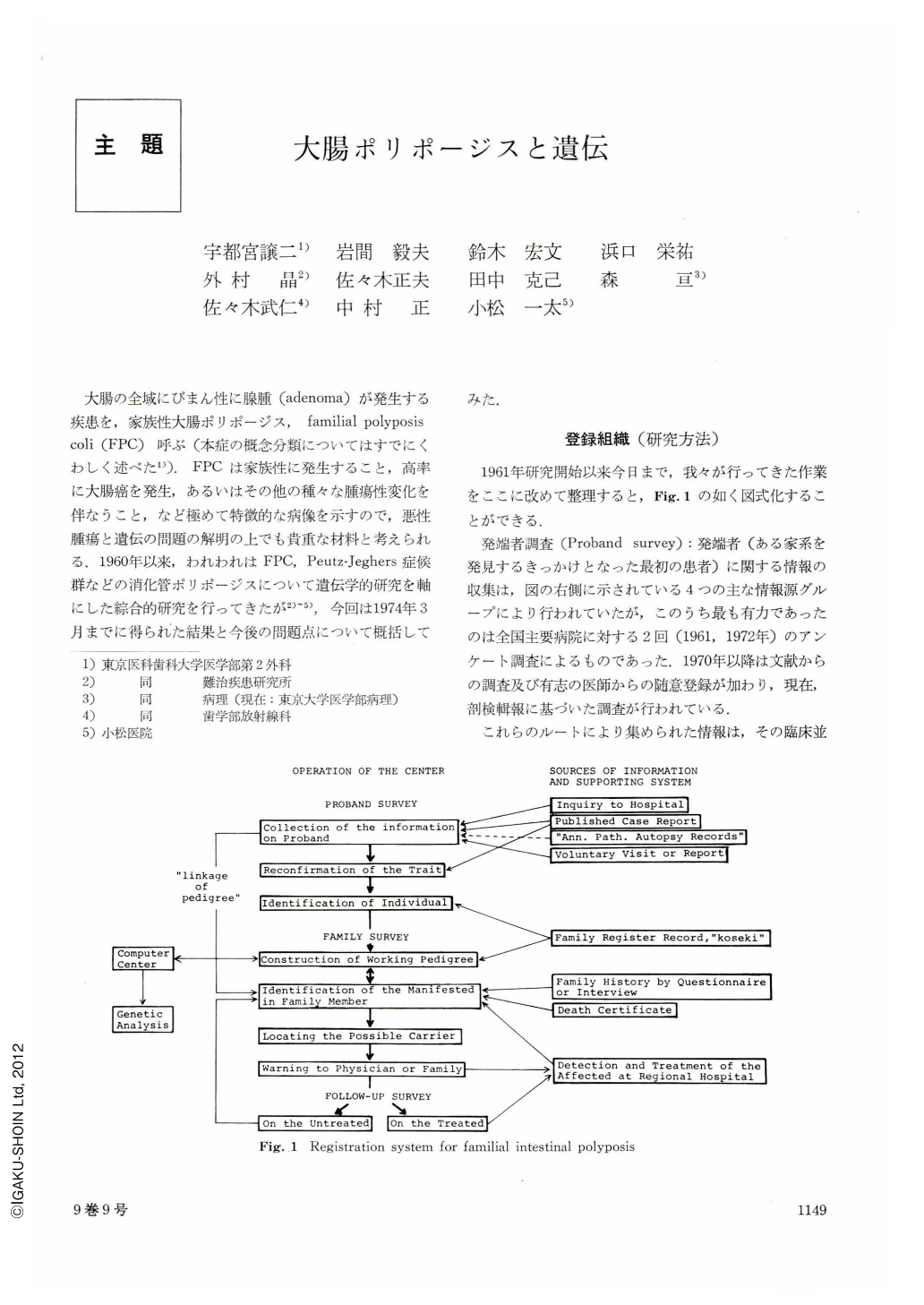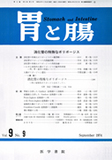Japanese
English
- 有料閲覧
- Abstract 文献概要
- 1ページ目 Look Inside
大腸の全域にびまん性に腺腫(adenoma)が発生する疾患を,家族性大腸ポリポージス,familial polyposis coli(FPC)呼ぶ(本症の概念分類についてはすでにくわしく述べた1).FPCは家族性に発生すること,高率に大腸癌を発生,あるいはその他の種々な腫瘍性変化を伴なうこと,など極めて特徴的な病像を示すので,悪性腫瘍と遺伝の問題の解明の上でも貴重な材料と考えられる.1960年以来,われわれはFPC,Peutz-Jeghers症候群などの消化管ポリポージスについて遺伝学的研究を軸にした綜合的研究を行ってきたが2)~5),今回は1974年3月までに得られた結果と今後の問題点について概括してみた.
登録組織(研究方法)
1961年研究開始以来今日まで,我々が行ってきた作業をここに改めて整理すると,Fig. 1の如く図式化することができる.
Central registration system
An attempt has been made to establish a central registration system for familial polyposis coli (FPC), which is defined as a so-called hereditary disease characterized by multiple adenomas deffusely distributed throughout the colon and rectum. The central registration system on this disease have been established. Information on the proband has been collected through random inquiries at hospitals, by questionaires on the cases published in clinical journals or in pathological autopy records, from the patients visiting us and from the physician's voluntary reports. Information on 205 cases belonging to 165 families has been collected at present and 37% of them are found to be published officially in the journals. The individuals are identified and their exact “Working pedigrees” are constructed covering at least 4th grade of consanquinity by means of reviewing the official family register record (Koseki) and the information on the affected relatives is being collected by communicating with the families of the patients and/or by reviewing the death certificates. The accumulated information is computerized for permanent preservation and analysis.
During these operations, linkage of independently registered pedigree has been infrequently observed. While the linkage occurs on the same generation level (“horizontal linkage”), it could also occur on the different levels (“vertical linkage”) as in a pedigree in which one of the antecedents of the propositus was found to have appeared in literature as an independent pedigree 40 years ago. Follow-up survey : In the initial inquiry group, we found newly affected cases six families during the following seven years. This happened in two families in which the disease had not been confirmed at the previous suvery in other than the propositi, so-called sporadic or non-familial case.
We actually confirmed more than 459 persons affected at present or in the past and were able to locate about 1,164 possible polyposis carriers requiring examination.
Expression of the trait
The age of onset of the initial symptom is considerably earlier in female (24.7 years en the average) than in male (31.6).
The earliest manifestation of the trait that we experienced was a single polyp detected in a girl of 8 years of age. The polyps are considered to increase in number with age. We have observed these over middle age with segmental distribution of polyps who were a member of typical FPC. Our study revealed that the “expressibility” of the colonic polyps is considerably different individuals as well as among the families, Veale's observation on juvenile polyposis in the family of FPC is considered as a phenomenon of “specificity”.
As extracolic lesions, gastric polyps are detected in 66%. Any one of Gardner's stigmated is detected in 35.7% of personal cases (incomplete type of FPC) while typical stigmata are associated in 7.1% (complete Gardnertype) and no stigmata are detected in 57.1% (simple FPC).
These data are considerably higher than those faund in survey group and indicate that FPC principally has the characteristics of producing dwerse types of extracolic neoplastic lesions, The reason for the existence of Gardner's syndrome could be explained by different grade of expressivility of “pleiotrophyic phenomenon”. Penetrance is calculated as 0.679.
Familial case and Non-familial case
After intensive family and follow up survey incidence of familial cases has been increased currently up to 0.52. However, there remained still 0.48 of non-familial cases. Our current data on relative fitness are 0.88. This produced 0.12 selection coefficient. This value showed still large discrepancy in the value of mutation coefficiency (0.41) calculated by us. Existence of phenocopy is not entirely neglected.
Mode of inheritance
Male to female ratio is 1 : 0.6; this is considered as “sex controlled effect”. Our analysis suggests that female individual carring the gene may be lost in early stage after birth as well as in utero for some reason. Segregation ratio is 0.377; this is modified by penetrance (0.68) to produce 0.554.

Copyright © 1974, Igaku-Shoin Ltd. All rights reserved.


